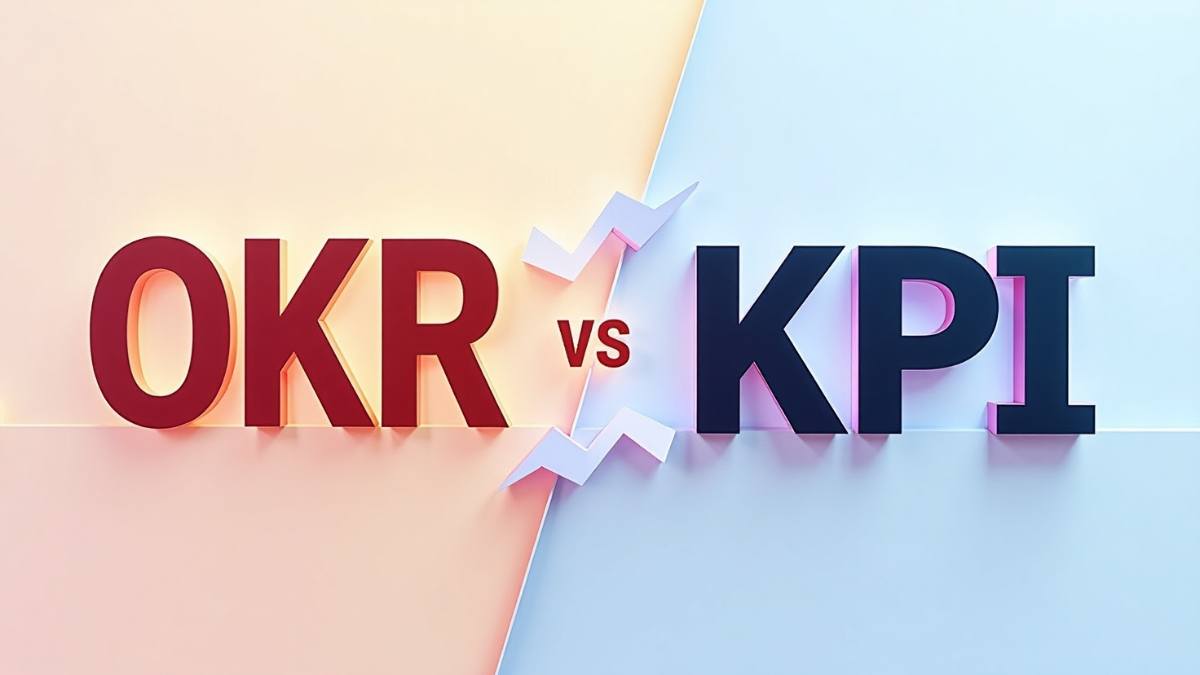Ever felt like your team is working hard but not really moving anywhere? Like you’re busy all day, but you’re not sure if you’re busy with the right things?
That’s exactly why businesses, whether it’s a two-person startup or a Fortune 500 giant, need solid ways to track progress and results.
And that’s where the whole “OKRs vs KPIs” conversation comes in.
If you’ve ever wondered what the real difference is between OKRs and KPIs (and honestly, a lot of people mix them up), this blog is going to clear it all up for you.
We’ll break down what each one means, when you should use OKRs, when KPIs make more sense, and whether they can actually work together for better growth.
Let’s get into it.
Table of Contents
What are OKRs?
Alright, let’s start with OKRs.
OKRs stand for Objectives and Key Results. Think of them as a goal-setting framework that helps teams stay aligned and focused on the big picture.
Here’s the basic formula:
- Objective: What do you want to achieve? (Ambitious but clear)
- Key Results: How will you measure if you’re getting there?
For example:
Objective: Become the go-to podcast in the digital marketing space.
Key Results:
1. Reach 50,000 monthly listeners
2. Land 5 guest appearances on other top podcasts
3. Grow newsletter subscribers by 30%
Why use OKRs?
They’re built for strategic alignment. Instead of just hitting numbers, OKRs push teams to chase meaningful, often ambitious goals. They’re especially useful when you’re trying to stretch beyond what’s “safe” or expected.
Who uses OKRs?
You’ll often find OKRs in tech startups, SaaS companies, and teams focused on innovation. Companies like Google, Spotify, and Netflix have famously used them.
But honestly? More and more marketing teams, product teams, and even solo entrepreneurs are adopting OKRs today.
Also Read: Effective SAAS Marketing Strategies
OKR Examples
OKRs can work on multiple levels, from your personal goals to entire organizations. Let’s look at some real examples:
1. Marketing Team Example
Objective: Boost brand visibility in the Indian startup ecosystem
Key Results:
- Publish 15 guest posts on popular startup blogs
- Increase LinkedIn engagement by 40%
- Reach 500 new newsletter subscribers
2. Product Team Example
Objective: Launch a seamless onboarding experience for new users
Key Results:
- Reduce signup drop-off rate by 25%
- Achieve 4.5/5 average onboarding satisfaction score
- Complete 5 user-testing rounds before launch
3. Company-Wide Example
Objective: Become a recognized leader in sustainable e-commerce by 2026
Key Results:
- Achieve 70% renewable packaging usage
- Get featured in 3 sustainability-focused media outlets
- Earn B Corp Certification by Q4
Notice how each Objective is a little bit dreamy, but the Key Results are always measurable.
What are KPIs (Key Performance Indicators)?
Now, let’s talk about KPIs, something you’ve probably heard in every business meeting ever.
KPIs stand for Key Performance Indicators, and they’re exactly what they sound like: indicators of how well you’re performing.
They’re numbers. Targets. Percentages. Things you can count and track regularly.
Here’s the thing about KPIs:
- They’re ongoing measurements.
- They tell you if you’re on track with daily or monthly performance.
- They can be small or large, depending on what you’re tracking.
For example:
KPI Example: Monthly website traffic = 100,000 visitors
Unlike OKRs, KPIs are not necessarily tied to big, inspirational goals. They’re about making sure your processes, strategies, and execution are working.
Who uses KPIs?
Literally everyone.
Sales teams, HR teams, marketing, customer support, operations, if there’s a job to be done, there’s probably a KPI tracking it.
Also Read: Key Product Management KPIs and Metrics
KPI Examples
KPIs work across every corner of a business. Here are some department-specific examples:
1. Sales Example
KPI: Monthly Revenue = ₹20 lakh target
Tracks whether the sales team is meeting financial goals.
2. HR Example
KPI: Employee Retention Rate = 95%
Helps HR measure the success of workplace culture or recruitment efforts.
3. Operations Example
KPI: Order Fulfillment Time = < 24 hours
Measures how quickly operations deliver on customer promises.
See the difference already? KPIs are more about performance checkpoints, while OKRs are about driving change or growth.
Also Read: Important Digital Marketing KPIs
OKRs vs KPIs: What’s the Real Difference?
| Aspect | OKRs (Objectives & Key Results) | KPIs (Key Performance Indicators) |
| Purpose & Intent | Set direction, align teams, and drive ambitious growth | Monitor performance, measure ongoing success |
| Structure & Format | Objective (qualitative) + 3–5 Key Results (quantitative) | Singular, specific, measurable metric |
| Timeframe | Set for a specific period (usually quarterly or annually) | Ongoing tracking (daily, weekly, monthly, quarterly) |
| Flexibility | Flexible; encourages stretch goals and innovation | Fixed; focused on maintaining or improving performance |
| Ownership | Shared across teams or departments for collaboration | Often assigned to individuals or specific teams |
| Measurement Focus | Measures outcomes, aiming for progress, even if not 100% achieved | Measures output, must meet specific benchmarks or targets |
| Strategic Value | Strategic, designed to push the organization forward | Tactical/Operational, designed to optimize current work |
| Success Criteria | Partial completion is acceptable if progress is made | Success = hitting or exceeding the set number or goal |
| Review Cadence | Reviewed at the end of the OKR cycle (quarter/year) | Reviewed continuously with regular reporting |
| Alignment | Aligns teams with company vision and larger strategic goals | Tracks team or individual performance on specific tasks |

Enroll Now: Advanced Digital Marketing Course
Should You Use OKRs or KPIs – Or Both?
So now the big question: Should you use OKRs or KPIs? Or both?
Honestly, both.
But when you use each depends on what you’re trying to achieve.
When to Use OKRs
If you’re launching something new, trying to grow, or heading into unknown territory, OKRs are your friend.
For example:
- Launching a new product line.
- Expanding into a new market.
- Trying to change company culture or brand perception.
They help set that direction and give everyone something exciting to chase, even if it feels a little scary or ambitious.
When to Use KPIs
If you already know what you’re doing, and you just need to keep it running smoothly, KPIs are the way to go.
Example:
- Daily sales numbers.
- Website bounce rate.
- Customer service response time.
They’re about stability and performance.
How They Can Complement Each Other
Here’s the thing: OKRs can actually include KPIs inside them.
Let me explain:
Objective: Become a trusted authority in SEO training in India
Key Result (KPI): Achieve an average blog traffic of 200K visits/month
See that? The KPI is actually supporting the OKR.
So, in many cases:
- OKRs = The why and what (direction)
- KPIs = The how well (measurement of progress)
If you run a growing business or team, the best approach is usually a hybrid model:
- Use OKRs to set direction.
- Use KPIs to track progress along the way.
Also read: What are Marketing Metrics
Where Both Work Together Beautifully
Let’s say you’re running an e-commerce brand:
- Your OKR is about launching in a new region.
- Your KPIs are things like order fulfillment time, ad ROI, and customer satisfaction.
Both working together = growth, with a sense of control.
Also Read: What Is Digital Marketing ROI: Key Metrics
Common Mistakes to Avoid
OKRs and KPIs are powerful tools. But like anything powerful, they can mess things up if you don’t handle them right. Let’s talk about the most common mistakes people make with both, so you can skip those headaches.
Mistakes With OKRs
1. Setting Too Many Objectives
This is the fastest way to make OKRs useless.
If everything is important, nothing is important.
What to do instead: Stick to 3-5 objectives max at any given time. Focus.
2. Making Key Results Too Vague or Binary
Example of a bad Key Result: “Launch new website.”
Cool… but did that improve anything?
What to do instead: Focus on measurable outcomes, like:
“Increase conversion rate by 15% after launching new website.”
3. Confusing OKRs With Tasks
“Post 5 times a week on LinkedIn” isn’t a Key Result. That’s a task.
What to do instead: Key Results should be outcomes, not activities.
Good Example: “Increase LinkedIn engagement by 40%.”
Mistakes With KPIs
1. Measuring What Doesn’t Matter
We’ve all seen dashboards packed with numbers no one looks at. Vanity metrics don’t help.
What to do instead: Choose KPIs that actually drive business decisions.
2. Using Too Many KPIs
Same problem as with OKRs. Too many = nobody cares anymore.
What to do instead: Stick to the critical few KPIs per goal.
3. Not Aligning KPIs With Strategic Goals
Imagine tracking “number of emails sent” when your goal is “build customer trust”. Pointless.
What to do instead: Make sure your KPIs feed into the bigger strategy.
How to Align OKRs and KPIs for Maximum Impact
Alright, here’s where we bring it all home.
Using OKRs and KPIs together is how great teams balance vision with execution. Here’s how to actually do that:
Use KPIs Inside Your OKRs
We touched on this earlier, KPIs can literally be your Key Results inside an OKR.
Example:
Objective: Improve product-market fit for our SaaS tool
Key Result (KPI): Increase Net Promoter Score (NPS) to 45+
The OKR = ambition.
The KPI = measurement of success.
Align Both With Overall Business Goals
Let’s say your company-wide OKR is to become the market leader in your niche.
Your teams should set OKRs and KPIs that push toward that same destination.
Example:
Company OKR: Become #1 SEO agency for startups in India
Marketing KPI: Organic search traffic growth = 25% quarter-over-quarter
Everything lines up → everyone rows in the same direction.
Conclusion
OKRs and KPIs aren’t competing systems, they’re two sides of the same coin. OKRs help you figure out where you want to go, especially when you’re aiming high or trying to build something new. KPIs help you track how well you’re doing along the way. The smartest businesses use both. If you only track KPIs, you might perform well but stay stuck in the same place. If you only set OKRs, you might chase goals without knowing if you’re on the right path. The real growth happens when you combine them. Use OKRs to dream bigger. Use KPIs to stay sharp. It’s not either-or, it’s both, working together.
FAQs: Difference Between OKRs and KPIs
1. Can a KPI be part of an OKR?
Yes, it can. A lot of the time, your Key Results are KPIs. Think of it this way: OKRs give you the big goal, and KPIs help you track if you’re actually making progress toward it. They work together naturally.
2. Which is better: OKRs or KPIs for small businesses?
Small businesses usually need both. OKRs help set direction when you’re growing or testing new ideas. KPIs help you stay on track with sales, operations, or marketing. Using both gives you clarity and ambition, without losing control of the numbers.
3. How often should OKRs and KPIs be reviewed?
OKRs should usually be reviewed every quarter. They’re for big-picture progress, so checking them monthly might feel rushed. KPIs depend on the business, daily, weekly, or monthly reviews work depending on what’s being tracked. The key is consistency.
4. What tools can I use to track OKRs and KPIs?
For OKRs, simple tools like Google Sheets work, but platforms like ClickUp, Weekdone, or Asana are better for teams. For KPIs, tools like Google Analytics, Databox, HubSpot, or CRM dashboards do the job well. It depends on your team’s setup.
5. Can OKRs replace KPIs in performance management?
No, they shouldn’t replace each other. OKRs are about goal-setting, while KPIs handle day-to-day performance tracking. They solve different problems. Using one without the other usually means missing part of the picture. The best setup combines both, aligned to your strategy.
6. Are OKRs and KPIs suitable for individuals, not just teams?
Definitely. Individuals can use OKRs to set personal growth goals, like learning a new skill or hitting career milestones. KPIs help measure specific progress, like number of completed courses or content output. Both work great on personal or team levels.

